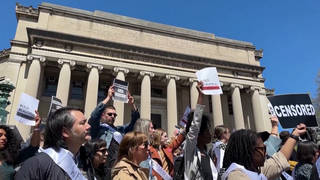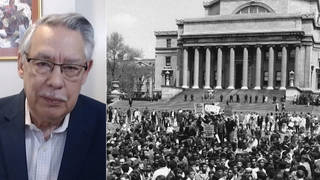
By Amy Goodman & Denis Moynihan
The nation is reliving the violent January 6th attack in the U.S. Capitol, as Democratic Congressmembers deliver a devastating case against Donald Trump in the ex-President’s historic second Senate impeachment trial. These nine House managers have assembled video and other evidence detailing Trump’s months-long campaign of lies claiming the 2020 election was stolen, and his consistent encouragement of violence, leading up to the Capitol attack. Their case has been methodical and comprehensive, but leaves largely untouched a fundamental feature of the insurrection: white supremacy. Even if at least 67 Senators vote to convict Trump for the single charge of incitement of insurrection and more than half vote to ban him from ever again holding public office, this trial will not advance the struggle in this country to overcome systemic racism.
The U.S. Capitol would be an appropriate location to launch an antiracist movement. Soaring rhetoric has filled the hallowed halls for more than two centuries, extolling liberty, freedom, justice, and equality. Yet, as we were reminded Wednesday by Congresswoman Stacey Plaskett, the delegate representing the U.S. Virgin Islands, one of the House impeachment managers, “This capitol that was conceived by our founding fathers…was built by slaves.”
Throughout the videos of the Trump-incited mob rampaging through the building, many with Confederate and Nazi flags and other white supremacist symbols, we catch glimpses of the famous Rotunda, the Crypt beneath it, and Statuary Hall. Each of the fifty states sends two statues to the Capitol, and they are placed throughout the complex, as Statuary Hall can only accommodate 35 of them. Of the 22 statues from the eleven Confederate states, at least 15 were slave owners, and ten of those remaining were Confederate officers or officials.
Last June, House Speaker Nancy Pelosi sent a letter to the Joint Committee on the Library, which manages Statuary Hall, asking that statues of Confederates be removed. The law, however, requires the states that sent the statues to approve any removal or replacement.
Virginia agreed, and removed its statue of General Robert E. Lee, leader of the Confederate Army. A statue of African American student organizer Barbara Johns will be put in its place. As a teen, Johns organized a strike at her high school, protesting the wretched conditions of her segregated school. A legal case followed, becoming part of the landmark Brown v. Board of Education Supreme Court decision outlawing segregation in public schools.
“It took the Civil War between the Union and the Confederate States of America for slavery to end,” Professor Ibram X. Kendi said on the Democracy Now! news hour. “The vice president of the Confederates was Alexander Stephens, who, last I checked, has a statue in Statuary Hall. Stephens said that this Confederacy is founded on the ‘great truth that the negro is not equal to the white man,’ and ‘slavery, subordination to the superior race, is his natural and normal condition.’”
It’s not just dead Confederates in the Capitol. North Carolina honors Charles Brantley Aycock, who was just a child during the Civil War. Aycock devoted his life to white supremacy. He was a lead organizer of the Wilmington Massacre of 1898, when a white mob of 2,000 armed racists attacked the elected, biracial local government, destroyed businesses, including the only Black-owned daily newspaper in the country, and killed between 60 and 300 Black residents. Aycock’s punishment? He was elected governor of North Carolina, then pushed through laws that disenfranchised African Americans.
There are also many statues honoring so-called Founding Fathers who were slave owners, among them George Washington, and Northerners Jonathan Trumbull of Connecticut and George Clinton, the first governor of New York.
History professors Kendi and Keisha Blain have just published a remarkable anthology titled, “Four Hundred Souls: A Community History of African America, 1619-2019.” It brings together 80 prominent African American writers, scholars and activists, each of whom contributed an essay covering a 5-year span from those 400 years of African American history.
“We were really thinking about how do we connect past to the present,” Blain said, explaining that the book, “helps us contextualize the history and to see some of the challenges that remain even to this day, how it connects to the period of slavery.”
After Trump’s racist supporters with their Confederate flags were cleared from the Capitol, leaving five dead and over 140 police officers injured, the National Guard moved in. Several African American soldiers posed for a photo with one of the Capitol’s newest statues, that of Rosa Parks. These memorials matter.
The Senate should convict Ex-President Donald Trump. But the root causes of the insurrection, racism and white supremacy, that Trump has embraced and exploited his whole life, will require far more work to overcome.










Media Options